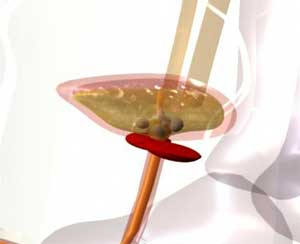Q: What is involved with using ICP?
A: Intermittent catheterization involves draining the bladder on a regular schedule by inserting a catheter into the urethra, draining the urine and then removing the catheter.
Outside the hospital most people use a clean (not sterile) technique to do this.
Q: How would I perform ICP?
A: To perform ICP you lay out all the needed supplies where you can get to them, wash your hands, and then wash the opening of your urethra.
Then you take a clean, lubricated catheter and insert it into the urethra and then push it into the bladder.
This usually is about 5 inches in distance in a male and about 1 � inches in a female.
You will need to either do this seated on the toilet or have a container available to drain the urine.
Q: When would I take the catheter out?
A: When the bladder is empty, usually after about a minute, you will remove the catheter.
Q: What would I do with the catheter when I take it out?
A: The catheter can then be washed, dried, and stored in a plastic bag. It generally can be used for at least a month.
Q: How often would I perform the catheterization?
A: Performing the catheterization every four to six hours avoids bladder accidents and keeps the bladder from getting overstretched.
Q: Would I be able to drink as much liquid as I want if I use ICP?
A: It is recommended that you restrict your fluid intake to 8 glasses of fluid a day using this technique.
Your goal in terms of urine volume should be to keep the urine volume about 1 � cups per catherization.
If the volume drained exceeds this then you will need to alter either your drinking or your catheterization schedule.
Q:Would I have to take any medications with the ICP technique?
A: Most SCI specialists recommend that people with spinal cord injury using intermittent catheterization take a bladder relaxing medication on a regular basis to prevent unwanted pressure on the kidneys.
These medicines also are used to prevent accidents between catheterizations.
Q: What are the advantages of the ICP approach?
A: ICP has a number of advantages. Urine is stored in the bladder and there are thus no odor problems or leg bags in view.
In addition to this, the incidence of infection is probably lower than with an indwelling catheter, although most people will still have an occasional infection.
Q:Would my fertility be affected by the ICP approach?
A: Fertility is generally not affected with ICP and intimacy is generally felt to be easier to manage with confidence as an ICP can be performed prior to initiating intimacy.
In general ICP is quite similar to how able-bodied persons manage the bladder.
The bladder fills and then when it is about full it is emptied.
Being able to keep a schedule is an important issue when using ICP.
Q: Are there short-term problems with ICP?
A: The short-term problems with ICP include accidents and infections.
An accident can occur between catheterizations and frequently it is large volume of urine.
If you have an arreflexic bladder this is not an issue.
Patients using this technique estimate that this occurs about once a month.
The rate of bladder infection is about 3 per year, usually needing treatment with oral antibiotics for a week or two.
Q: Are there different infection problems for men and women?
A: For men, infection in the testicles and tubes that carry the sperm from the testicles may develop and need to be treated.
Because all of these structures are close together, with catheter use an infection can be introduced into these areas.
Normally they can be treated with antibiotics that you take by mouth.
These infections may decrease fertility.
There are no known gynecological problems with ICP for women although yeast infections may develop during the course of antibiotic treatments for urinary infections.
Q: Are there long-term problems with ICP?
A: Long-term issues for ICP include bladder and kidney stones that may result from any technique that uses a catheter.
Stones are less frequent in ICP than in indwelling catheter use, but are more common than in any of the catheter free approaches.
There is a small increase in the incidence of bladder cancer with intermittent catheterization that develops after about ten years of use.
Regular medical follow-up will generally be sufficient to detect this problem early if it were to occur.
Q: What could I do to make sure the ICP approach will work for me?
A: There are three key elements to making this technique work:
1. Limiting fluid intake
2. Taking care to be as clean as possible when performing the catheterization
3. Regular follow-up with your health professional is important.







